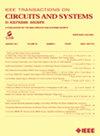ZRHDC: A Lightweight HDC Architecture With Zero ROM Overhead
IF 4.9
2区 工程技术
Q2 ENGINEERING, ELECTRICAL & ELECTRONIC
IEEE Transactions on Circuits and Systems II: Express Briefs
Pub Date : 2025-07-04
DOI:10.1109/TCSII.2025.3585931
引用次数: 0
Abstract
Hyper-Dimensional Computing (HDC) is an efficient learning paradigm inspired by the high-dimensional properties of human brain. However, existing HDC architectures require large storage overhead to store position and level hyper-vectors, increasing the chip area while also limiting the expansion of dimensions. To solve this problem, we propose a lightweight HDC architecture with Zero Rom overhead, named as ZRHDC. Utilizing a novel parallel encoding method and a rapid random vector generation mechanism based on Linear Feedback Shift Register and shift-flip operations, ZRHDC accelerates encoding process and completely eliminates the ROM overhead. The proposed architecture supports classification tasks with up to 32 categories, 1024 features and 8192 dimensions, achieving 2-ZRHDC:一个轻量级的HDC架构,零ROM开销
HDC (Hyper-Dimensional Computing)是一种受人脑高维特性启发的高效学习范式。然而,现有的HDC架构需要大量的存储开销来存储位置和水平超向量,这增加了芯片面积,同时也限制了尺寸的扩展。为了解决这个问题,我们提出了一个零Rom开销的轻量级HDC架构,命名为ZRHDC。利用一种新颖的并行编码方法和基于线性反馈移位寄存器和移位翻转操作的快速随机向量生成机制,ZRHDC加速了编码过程,完全消除了ROM开销。拟议的架构支持多达32个类别,1024个特征和8192个维度的分类任务,与最先进的ASIC设计相比,实现了2- 8倍的维度扩展,并提高了各种任务和训练策略的准确性。此外,我们的芯片在55nm的成本仅为0.66mm2,实现了3- 6美元的面积缩小。仿真结果表明,该方法在执行肌电手势识别任务时功耗为0.771mW,待机时功耗仅为0.009mW。
本文章由计算机程序翻译,如有差异,请以英文原文为准。
求助全文
约1分钟内获得全文
求助全文
来源期刊
CiteScore
7.90
自引率
20.50%
发文量
883
审稿时长
3.0 months
期刊介绍:
TCAS II publishes brief papers in the field specified by the theory, analysis, design, and practical implementations of circuits, and the application of circuit techniques to systems and to signal processing. Included is the whole spectrum from basic scientific theory to industrial applications. The field of interest covered includes:
Circuits: Analog, Digital and Mixed Signal Circuits and Systems
Nonlinear Circuits and Systems, Integrated Sensors, MEMS and Systems on Chip, Nanoscale Circuits and Systems, Optoelectronic
Circuits and Systems, Power Electronics and Systems
Software for Analog-and-Logic Circuits and Systems
Control aspects of Circuits and Systems.

 求助内容:
求助内容: 应助结果提醒方式:
应助结果提醒方式:


